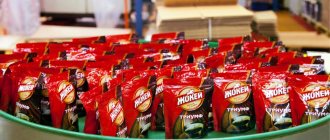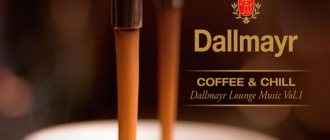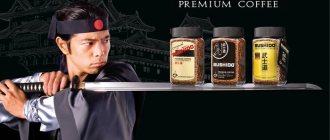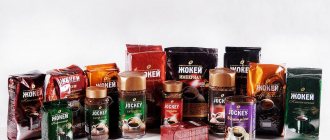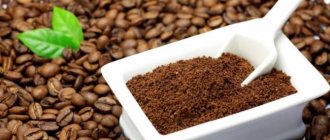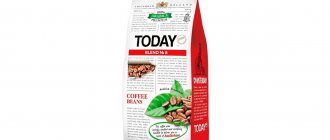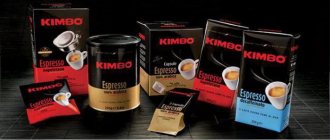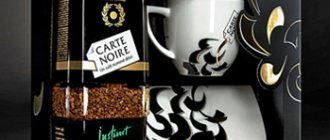A few words about the Jacobs brand
The history of the Jacobs company begins at the end of the 19th century, when entrepreneur Johann Jacobs from Germany decided to open his own shop with sweets and coffee. Visitors appreciated the grain product most of all, which very soon became very popular. After some time, the entrepreneur expands the scale of his activities and opens a large store on the main street of Bremen.
Thus, at the beginning of the 20th century, the first coffee roasting plant was founded, which was named after Johann Jacobs. A few years later, the Jacobs Kaffee brand was formalized. Since then, the products began to be packaged in branded packaging with the image of a bag filled with coffee beans.
One of the manufacturer’s services was delivery of products to customers’ homes.
During the First World War, the plant was on the verge of closure. Since the sale of coffee beans was prohibited during wartime, Jacobs Kaffee were forced to sell grocery products: sugar, cereals, etc. After the end of the war, coffee products gained popularity again. Then Johann Jacobs, with the support of his talented nephew, revived the enterprise, which began production with redoubled effort. In 1934, the entrepreneur opened a new plant, which at that time employed more than 300 employees.
Since the 60s, Johann Jacobs has handed over the management of the plant to his grandson. The volume of production is growing every year, production is increasing, Jacobs coffee occupies a leading position not only in Germany, but also in other European countries.
Advantages of Jacobs monarch
Jacobs is in great demand due to the following criteria:
- product quality that is maintained over many years of production;
- assortment to suit different tastes;
- price accessible to buyers with different incomes;
- reasonable advertising policy.
Thanks to this, the prevalence of this brand’s products is growing every year, reaching more and more countries.
Jacobs coffee range
Until 2000, the brand’s products were brought to Russia from Finland, and then a Jacobs coffee production plant was opened near St. Petersburg. Here they make their favorite drink from Arabica and Robusta beans, which are purchased from different countries.
The manufacturer produces two main types of coffee;
- ground;
- soluble.
The plant also produces Tassimo capsules, but bean coffee is practically not produced in Russia. For comparison, in Germany there is a special dedicated line for the production of grain products.
Natural coffe
In our country, Jacobs produces only one type of coffee beans - Monarch classic. In Germany, grain products are the main product. Monarch and Espresso beans are sold in vacuum packages of 1 kg. This is mainly Brazilian Arabica, which differs in the degree of roasting and blending: Monarch is lighter roasted, with light fruity notes, Espresso is darker, with a rich taste.
Jacobs Monarch ground coffee is available in a variety of grinding and roasting options. The crushed product is in greater demand than grains, so the manufacturer gives its consumers the opportunity to choose:
- Jacobs Monarch classic. Asian Robusta and Latin American Arabica combined give a deep, rich taste and aroma.
- Croning. Available in a green vacuum pack. Thanks to the fine grinding, it is possible to brew the drink in a Turk or simply pour boiling water in a cup for 5 minutes.
- Jacobs Monarch for the Turks. A finer grind makes it possible to create a delicious drink with a beautiful foam on the stovetop.
- Jacobs Espresso. Made from deep roasted beans, it is strong and has a rich, rich flavour. A cup of drink will give you vigor and energize you for the whole day.
- Coffee capsules Tassimo. The product was created for coffee machines and is available in several types: Espresso has a rich taste and bitter notes, Crema is soft, with a small amount of caffeine, Latte macciato is with delicate milk foam.
Jacobs instant coffee
The freeze-dried product is produced using an innovative freeze-drying method, resulting in beautiful coffee granules. Instant Jacobs can be recognized by its unchanged glass jars with green labels and lids that screw tightly on, allowing the unique coffee aroma to be preserved. Instant food products are in particular demand due to their rich taste and ease of use.
Popular types of Jacobs instant coffee:
- Jacobs Monarch. Branded taste in crystals, packaged in glass containers with a green lid.
- Jacobs Monarch Intense. The roasting is stronger, resulting in a strong drink with bitter notes.
- Jacobs Monarch Decaf. The classic taste remains, but the caffeine level is reduced. The products will appeal to those who, due to some circumstances, do not drink caffeine.
- Jacobs Gold. The roast is light, the taste is soft and delicate, while the aroma is still rich.
- Jacobs Velor. The product is produced not in crystals, but in powder form. The finished drink has a pleasant thick foam on the surface.
- Jacobs Millicano. The smallest particles of ground coffee are placed into sublimate granules, resulting in ground coffee in instant form. In a few seconds you can prepare an amazing drink with the taste and aroma of natural coffee in a cup. There is usually a small sediment left at the bottom.
- Jacobs 3 in 1. One bag contains coffee powder, sugar, dry cream or milk, and flavoring. Jacobs 3 in 1 coffee, which comes in sticks, is convenient to take with you on trips or to use at work when there is no time or opportunity to prepare a natural drink. The manufacturer offers several flavors of instant sublimate: classic, cappuccino, strong, latte caramel, soft.
3 in 1 sticks can be purchased individually or in large packages.
Capsules for coffee machines
For the well-known Tassimo coffee machines, the manufacturer has established a process for producing special capsules. The modern device is an intelligent system that independently calculates the amount of water and sets the desired temperature in order to prepare the drink.
Tassimo capsule range:
- Jacobs Americano;
- Cappuccino;
- Latte Macchiato;
- Latte Macchiato Caramel;
- Cafe Crema;
- Espresso.
Let's sum it up
Jacobs Monarch is a product produced by a brand with a long history. The popularity of the drink from this company was due to its pleasant taste and aroma. At the moment, a coffee lover can enjoy his favorite drink in grain, ground, instant or freeze-dried form. It all depends on the ability to prepare it in the traditional way, quickly brew it in a cup, or. And attention to detail will allow you to distinguish the original from the fake.
The history of the Jacobs coffee brand began more than a century ago and is associated with the German entrepreneur Johann Jacobs
, who was born on May 20, 1869 in the family of a simple peasant.
Until the age of 14, Johann attended a rural school, and later became a student at a commercial school, where he studied the intricacies of trading colonial goods. His teacher Karl Ferdinand was able to correctly identify his student's interest and advised him to specialize in coffee. As an assistant, Johann Jacobs began working in Würdemann's firm, where he rose to the position of trustee.
In 1895, in the German city of Bremen, Johann Jacobs opened his own shop, specializing in the sale of coffee, tea, biscuits, cookies and chocolate. This year is the starting point for the history of the world famous brand.
The store began to be a success among German residents. Perhaps this was greatly facilitated by the fact that after a series of moves, Jacobs’ store was located on the main shopping street of Bremen. 11 years later, Johann, inspired by success, opened his first factory specializing in roasting coffee beans, already known as Coffee Jacobs. And in 1913 the Jacobs
.
In 1934, a large coffee roaster was opened, employing up to 300 people and delivering freshly roasted beans to stores in its own branded vehicles. It is noteworthy that the roaster was an incredible success - deliveries to the specified addresses were made up to four times a day!
During the First World War, the company had a hard time, to put it mildly - the sale of coffee was prohibited, so the plant temporarily had to focus on other food products - rice, sugar, etc. And in 1920, Johann tried his hand at the securities industry. However, after the end of the war, coffee sales resumed.
After the monetary reform of 1923, the enterprise looked rather deplorable. In reality, it represented more areas for production, rather than production itself. But Johann Jacobs and his son Walter, who joined the company in 1929, were able not only to return the company to its previous positions, but also to conquer new heights. Not the least role in this was played by the sales policy of Walter Jacobs, who offered freshly roasted coffee to retail stores.
In 1938, annual coffee sales amounted to 12.75 billion imperial marks.
During the Second World War, the enterprise was almost completely destroyed, but it was still managed to be defended. Johann Jacobs, who was 76 years old at that time, had to start his coffee business for the third time, virtually from scratch. And luck was on his side again. The Jacobs coffee brand became known throughout West Germany, and in the mid-60s, more than 1,000 branded vehicles delivered Jacobs coffee to 60,000 stores throughout the country. 10 years after the end of the war, the Jacobs brand became the leader in the German coffee market.
In 1966, the Jacobs product line introduced Kronung
,
Tradition
,
Priva
and
Edel Mocca
.
For the first time, the company expanded beyond Germany and opened the market in Austria and then Switzerland. Since by that time the founder of the coffee empire was over 80 years old, his grandson Klaus took up further expansion. He began opening offices in various European countries, including Denmark, France, and a little later he reached Canada. In some countries, it acquired local coffee companies.
Throughout their lives, the Jacobs family was actively involved in charity work. For example, the University of Bremen was built with company money.
In 1990, the Jacobs brand became owned by Kraft Foods Inc. is the world's second largest packaged food company after Nestle. In 2012 Kraft Foods Inc. was divided, one of the divisions of which was named Mondelez International. It is this group that today includes the Jacobs brand.
There are several main types of Jacobs coffee on the market today: Monarch
,
Aroma
,
Cappuccino
and
Night and Day
. The most popular of them is Monarch.
It is worth noting that this type of coffee is designed for the mass consumer, as evidenced by the high level of sales. However, Jacobs coffee has many devoted connoisseurs.
This thread contains reviews of completely different types of Jacobs Monarch ground coffee. Therefore, for complete clarity, I would like to immediately emphasize the following points:
- The review refers to coffee with barcode 4607001777045;
- the full name on the package is “Jacobs Monarch Classic Ground Coffee”, 230g pack;
- the word “fried” is not in the name, although it is clear that this is so;
- coffee is produced in the Leningrad region for the Russian market (and not in Germany for the Ukrainian market, as in the previous review in this thread);
- The coffee packaging is designed exactly as in the photo in the review; the design on the packaging is significantly different from the main photo in the thread.
I bought Jacobs Monarch ground classic coffee by pure chance. Usually I don’t look at this brand at all, because I don’t drink instant coffee at all. And then there was some kind of generous promotion at “Magnit” for Jacobs Monarch and this type of coffee was put up with a yellow price tag in the most prominent place. 125 rubles a pack. At such a bargain price, why not give it a try? I bought it, of course.
I certainly didn’t expect miracles from this brand. But I'll be honest: the coffee is very mediocre.
The packaging, as always, contains the most information about the history of the brand. About the coffee itself only in passing: America and Asia, a mixture. The roast should be medium, closer to light: 3 out of 6.
This coffee is produced by Jacobs Dow Egberts Rus LLC in the Leningrad region. Like soluble, probably.
You can brew it in a cup. As with all other methods known to humanity today, however.
The grinding is really medium, but still closer to fine (as for Turks). The roast color is rather dark. But you can’t call him light, at least. There is a scent. But it’s kind of weak and not at all impressive. The smell is similar to cheap Robusta. The plus is that the smell is not burnt or rancid, there is no note of bitterness in it.
I brew it in a mug with boiling water. Jacobs Monarch ground coffee has a distinct tendency to form lumps. This is already very noticeable in the mug, although it can also be seen in the previous photo with dry ground coffee.
The cap is high and thick, heterogeneous (thicker at the bottom). There is no doubt that this is ground coffee.
Judging by the nature of the foam, Jacobs Monarch is classic - a mixture of Arabica and Robusta. And there is more Robusta in this blend than Arabica.
After gently stirring with a spoon, the foam still remains, but it becomes much lighter. The color of the drink is quite dark, which is typical for dark roasting.
The taste is unremarkable. Coffee? Yes. But absolutely without any peculiarities. With a good imagination, you can hear some bread and nut notes in the taste, characteristic of Arabica. But these notes are very inexpressive. The coffee is not sour at all. And that's a plus. But there is a little more bitterness in it than I would like. At least with sugar and milk it will do just fine.
The coffee is completely ordinary. But you can drink. In any case, better than instant.
Jacobs – coffee brand
, which has a centuries-old history. The history of the brand in Germany began with the opening in the city of Bremen by the then unknown German John Jacobs of a small shop selling chocolate, biscuits, cocoa, tea and coffee. Jacobs' bean coffee was a great success among the German population, and the store soon moved to Bremen's main shopping street.
The first name of the creator appeared in the name in the year when he founded the first factory engaged in roasting coffee beans. Official registration of the brand TM Jacobs
occurred 7 years later in the year. In order to attract customers, the factory delivered freshly roasted grains to customer addresses up to 4 times a day.
The First World War almost succeeded in destroying Jacobs' business. Because of the ban on coffee trading, the enterprising German had to turn his attention to other areas: hospital nutrition, the securities market. Attempts in these areas have been unsuccessful. Therefore, in the town of Jacobs, the restoration of coffee production begins. And John, together with his son Walter, opens a large brazier. And by the year the enterprise's turnover is about 13 billion. imperial stamps.
The next test for business was the Second World War. But this did not break Johann Jacobs. He found the strength to get the coffee company going again. And this year Jacobs becomes the undoubted leader in this field of activity in his native country.
In the 60s, under the leadership of Klaus, the grandson of the founder, the brand began to conquer new countries: Austria, Switzerland, then Denmark and France. Later he reaches Canada. The Jacobs brand enters Russia during a successful period of weak competition and occupies a strong position in the coffee market.
DE Master Blenders BV connection ended in July
and
Mondelez International, Inc.
and the formation of
Jacobs Douwe Egberts (JDE)
.
This merger received approval from the European Commission in May 2015. It was decided to organize the JDE headquarters in the Netherlands. Under the auspices of JDE, famous brands are collected: Jacobs, Tassimo, Moccona, Senseo, Gevalia, Kenco and Pilao
.
The representative of JDE in Russia is Jacobs Rus LLC
under the leadership of the General Director - Tatyana Efremova.
The society represents coffee brands beloved by Russian citizens: the famous Jacobs Monarch
and the new
Jacobs Monarch Millicano
,
Jacobs Velor
and
Tassimo
. Jacobs Rus LLC also owns a plant near St. Petersburg that produces freeze-dried coffee. This is one of the most modernized coffee factories in the world. This is where a new product is launched: Tassimo in T-discs. The information contained on the T-disc wrappers allows the coffee machine to determine the required preparation time and water volume.
- The university in Bremen bears the surname Jacobs in gratitude for investments received from the Swiss Klaus Johan Jacobs Foundation in 2006 in the amount of 200 million euros.
- Several new products for 2021 are presented
:
Millicano
- a mixture of powder with finely ground coffee;
Tassimo
is a capsule (for coffee machines) containing various coffee flavors:
cappuccino, espresso, latte macchiato and coffee crema
. The packaging is also varied: from glass jars to special bags. In terms of design, only the familiar green color, crown and gold stripe remain unchanged.
Jacobs, whose easily recognizable packaging is on the shelves of any Russian store, is one of the first places in Russia in terms of sales. The widest range of products produced by the Jacobs company includes different varieties of instant, bean and ground coffee, which have different degrees of strength and can satisfy the needs of any consumer. This also applies to the variety of packaging: all products are packaged by the manufacturer both in special bags and in glass jars.
Composition and energy value of Jacobs coffee
The content of active substances, nutritional and energy values vary depending on the specific product. Calorie content of ground Jacobs Monarch coffee (per 100 g) – 201 kcal. Nutritional value in g per 100 g of dry matter:
- proteins – 13.9;
- fats – 14.4;
- carbohydrates – 4.1.
Instant coffee Jacobs Monarch, calorie content and main chemical composition per 100 g:
- proteins – 14.6 g;
- fats – 3.5 g;
- carbohydrates – 0 g;
- energy value – 94 kcal.
Calorie content of coffee beans – 223 kcal, nutritional value:
- proteins – 13.9 g;
- fats – 14.4 g;
- carbohydrates – 15.6 g.
Based on this, the lowest calorie product is the soluble (granulated) version of the product. To prepare a standard serving of the drink, take an average of two teaspoons (about 8 g of granules). As a result, a cup of Jacobs instant coffee will contain 14-15 kcal.
One teaspoon of ground product contains approximately 8-12 kcal, soluble - 4 kcal. A cup of the grain version contains approximately 33 kcal, and a drink made from ground grains contains 30 kcal. Caloric content of Jacobs Millicano coffee is 115.25 kcal/100 g of dry powder.
The main substance in coffee beans is caffeine, which gives a boost of vigor and energy for a long time. But fans of the instant drink often wonder whether this alkaloid is present in it, for which many use the product. The caffeine content in Jacobs Monarch instant coffee is 3.3%. According to generally accepted standards, the percentage of alkaloid in products should not be lower than 2.8%.
How much does Jacobs coffee cost?
Price table for Jacobs instant coffee (in rubles)
| Name | 12.6 g (x12 pack) | 47.5 g | 75 g | 95 g | 140 g | 150 g | 190 g | 240 g | 250 g | 500 g |
| Jacobs Monarch instant | 100-120 | 125-150 | 160-450 | — | 230-260 | 325-540 | 320-700 | — | 750-1155 | |
| Jacobs Millicano (ground in instant) | — | — | 125-300 | — | — | 157-320 | — | — | 500-818 | — |
| Jacobs Gold | — | — | — | 220-350 | 290-350 | — | — | — | — | — |
| Jacobs Velor | — | — | — | 200-300 | — | — | — | — | — | — |
| 3 in 1 | 130-220 | — | — | — | — | — | — | — | — | — |
| Instant decaffeinated | 240-300 | — | — | — | — | — | — | — | — | — |
Jacobs ground and bean coffee price table (in rubles)
| Name | 150 g | 230 g | 800 g |
| Ground Jacobs Monarch | 140-300 | 200-350 | — |
| Ground Jacobs Monarch for brewing in a cup | 250-350 | — | — |
| Coffee beans | — | 220-300 | 900-1110 |
“Jacobs Milicano” - reviews from coffee lovers and lovers
Many fans of the black drink of vigor believe that it has an unsurpassed taste and aroma. This is a successful combination of instant and ground coffee. The new product became popular. Jacobs Milicano coffee, the price of which is within 500 rubles per 100 g, is available to all segments of the population.
Its unique aroma captivates you as soon as you open the lid of the jar. Convenient to prepare, if you buy, then only “Jacobs Milicano”, according to coffee lovers and lovers.
Among the entire assortment, this variety stands on its own. Some people like the tart and strong taste of ground freshly brewed coffee, while others like the subtle, elegant and delicate taste of instant coffee, and Arabica lovers feel a slight sourness and a pleasant aftertaste. But everyone appreciates this wonderful invigorating drink.
How to distinguish from a fake?
The Jacobs brand is known all over the world, so some unscrupulous manufacturers counterfeit popular products, profiting from the trust of customers. Sometimes it is very difficult to distinguish a counterfeit Jacobs from the original, but if you pay attention to some important nuances, the chance of not purchasing a counterfeit increases significantly.
How to distinguish a fake from the original:
- Price. Branded products cannot be cheap, so if you see a dubious number on the price tag, there will probably be chicory or malt inside the can or bag.
- Package. The manufacturer uses glass or tin containers to package its products so that the aroma of coffee is preserved for as long as possible. Counterfeiters choose the cheapest packaging for packaging counterfeit coffee, usually made of plastic.
- Product design. The marking of the original coffee is applied directly to the container. There should be no stickers or additional labels. The manufacturer must indicate the following information: country where the product was produced, original barcode, expiration date.
- Barcode. It carries important information for the consumer. The first three digits indicate the country of manufacture. It is important to calculate the numbers using a special formula so that the verification number matches.
- Packaging design. The original packaging fully matches the manufacturer's style. Often, counterfeiters copy the design and apply the company logo, swapping the letters.
How to determine quality
The popularity of the brand suggests the existence of counterfeits of the original. To avoid purchasing a product of dubious quality under the guise of good coffee, you should follow a number of rules:
- for purchases, you should choose specialized or trusted retail outlets with a good reputation;
- the main identifier of the original product will be the manufacturing date stamped on the pack, as well as a special trademark;
- special attention should be paid to the integrity of the packaging;
- Since the victims of counterfeiting are often cheap, instant varieties, it is worth giving preference to grain types of the drink, or Jacobs monarch millicano coffee.
Another way to recognize a fake is to study the barcode. To do this, you should know that the first 4 digits are the code of the country of origin. And if the code does not start with the order 40-44, indicating Germany, or indicating an official Russian manufacturer, it makes sense to doubt the quality of the product.
Having purchased the first package and made sure of the authenticity of the contents, you should save it until your next trip to the store for an invigorating drink. This will allow you to select the desired product by comparison.
